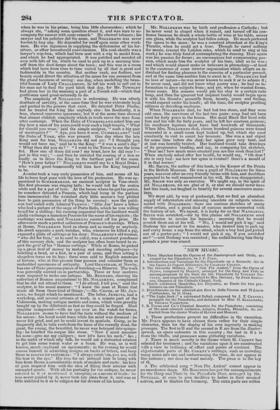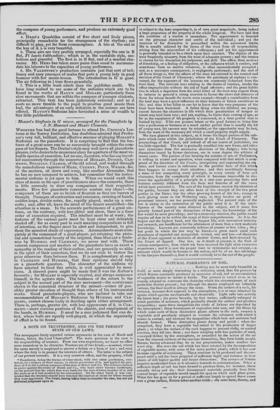shapeless torso on its legs : these were sold to
English amateurs 1. Three Marches from the Operas of the Zauberspruch and Well°, ar-
ranged for the Pianoforte, by J. P. Pixis.
of fortune, who at this present time possess and consider them as 2. Introduction and Variations for the Pianoforte on a favourite Air in has one of these precious pieces of botching—a Minerva, The work 3. The favourite Military Air, "Non Piu Andrai," from the Opera of was generally carried on in partnership. Three or four moderns Figaro, composed by MOZART, arranged for the Harp and Flute as
accompaniments to the Duet for the Pianoforte by VINCENT No-
were required to make one antique. Mr. BERNA.RD, showing his VELLO, and respectfully inscribed to Mrs. Dawney, by JOHN ROBIN- that he did not attend to them. "I do attend, I tell you," said the 4. Herz's celebrated Quadrilles, Les Elegantes, as Duets for two per- made all them there kind of things ;"—Mr. CRONE, or Mr. JEN- 5. Divertimento on the admired airs Ecco la Bella Vezzosa and Ti Lascio T'abbanclano, by H. Hzaz.
6. " The Light Bark e' a celebrated Ballad, composed by J. T. CRAVEN; workshop, and several artisans at work, in a remote part of the arranged for the Pianoforte, and dedicated to Miss H. KIALLMARK, bought up by the dillettanti as fast as they could be forged. Most 7. R. COCKS and Co.'s Classical Beauties for the Pianoforte ; consisting singular compound—with an eye ever on the watch for forms, of the most admired Andantes, Adagios, Rondos, Minuetts, &c. ex- his senses : his hand could trace while his mind was dormant : he I. These productions present no difficulties in the execution. never felt grief, and yet he could invent its symbols. Going, as he Mr. Pixis appears to have chosen them rather for their simple frequently did, to take casts from the faces of the recently dead, the character, than for the display of his own ingenuity in making great, the young, the beautiful, he never was betrayed into sympa- passages. The first in D and the second in E are from the Zauber- thy : he handled the corpse like stone. "Now I- must measure sprach, an opera unknown in this country ; the last in B b is his nose—give me my calipers; now let's have his neck," &e. ; from the Otello, and possesses some glittering variations. the compass of young performers, and produce an extremely good effect.
4. Hanes Quadrilles consist of five short and lively pieces, principally remarkable for the strangeness of the rhythm ; not difficult to play, yet far from commonplace. A trio at the end in the key of A I, is very beautiful.
5. These airs are very prettily arranged, especially the one in E flat, Ti laseio tabbandano ; which is in the cantabile style, me- lodious and graceful. The first is in B flat, and of a martial cha- racter. Mr. HERZ has taken more pains than usual to accommo- date his labours to the capacities of young performers. 6. Mr. VALENTINE'S production contains just that sort of bril- liancy and easy passages of scales that puts a young lady in good humour with her music-lesson. The introduction in G is good. The air following in time flows gracefully. 7. This is a little work which does the publisher credit. We have long wished to see some of the melodies which are to be found in the works of HADYN and MOZART, particularly those slow movements that are within the compass of younger students, extracted. This task has been judiciously executed; and as it costs no more trouble to the pupil to practise good music than bad, the advantages of an early initiation in the science are here offered. HAYDN'S Sinfonias have furnished a mine of wealth to this little publication.
Mozart's Sinfonia in G minor, arranged for the Pianoforte by J. N. Hummel and Muzto Clementi. WHOEVER has had the good fortune to attend Dr. Cnorcifs Lec- tures at the Surrey Institution, has doubtless admired that Profes- sor's very full, brilliant, and effective manner of playing MOZART'S Sinfonias on the pianoforte. It is surprising to find that the fea- tures of a great score can be so accurately brought within the com- pass of ten fingers. The Doctor's style may well serve all pianoforte- players, (who desire to be musicians also) for apattern of the most va- luable species of execution. Let no one, therefore, who having travel- led successively through the concertos of MOZART, DUSSEK, OLE- MENTI, STEIBELT, CRAMER, of the old school, and waded through the unmelodious vagaries of HERZ, CZ ERNY, PIXIS, WEBER, &c. of the modern, sit -down and weep, like another Alexander, that he has no new conquest to achieve, but remember that the instru- mental sinfonia is yet open to him. When we would exalt this class of music in the eyes of practitioners above the concerto, there is little necessity to draw any comparison of their respective merits. How few pianoforte concertos contain any ideas !—the composers of them are as lavish of flourish as they are barren of thought. Passages of contraction and extension, crossing of hands, sudden leaps, double notes, &e., rapidly played, make up a con- certo; and, after all, leave the'mind of the hearer unsatisfied—his attention in a maze. In the accurate performance of a great sin- fonia, on the contrary, with less glitter and show, there is a finer order of execution required. The intellect must be at work; the features of the various parts must be kept clear and delicately shaded off; for as every part in such meaning compositions is full of intention, so the fingers must be alert and independent, to give them the minutest shade of expression. Arrangements more com- pletely at the command of a good player, yet retaining the picto- rial and symmetrical beauty of the original, than MOZART'S Sinfo- nias by HUMMEL and CLEMENTI, we never met with. These veteran composers and masters of the pianoforte have so exact a sympathy in the reading of their author, and are generally so alike in the spirit of their execution, that we do not wish to bestow the prize otherwise than between them. It is complimentary at once to CLEMENTI and HUMMEL, that their opinions should tally on a pianoforte question. The character of the sinfonia we have selected to head this article, is well appreciated by musi- cians. A shrewd guess might be made that it was the Author's favourite ; for MOZART is especially excited, and always surpasses himself, in the agitato style. The boldness of the return to the subject in the second part of the slow movement—the contrivance shown in the canonical structure of the minuet—evince (if pos- sible) greater elevation of thought than others of his instrumental works. Good pianoforte-players, who are inclined to take our recommendation of MOZART'S Sinfonias by HUMMEL and CLE- MENTI, cannot choose badly in deciding upon either arrangement. There is, perhaps, greater art, with less appearance of it, in CLE- MENTI—more curious positions of the chords, and employment of the hands, in HUMMEL. It must be a nice judgment that can de- tect, where both are equally well-played, in which the superiority of effect is to be found.



















 Previous page
Previous page